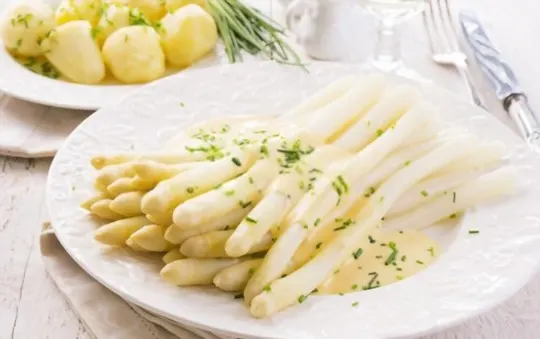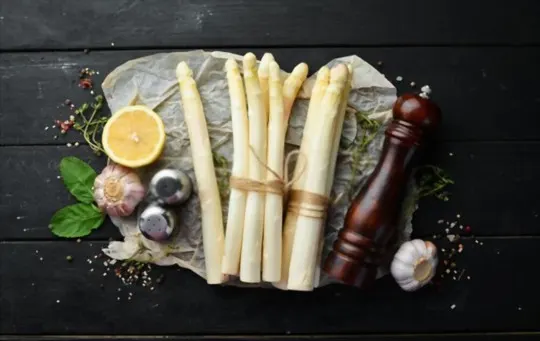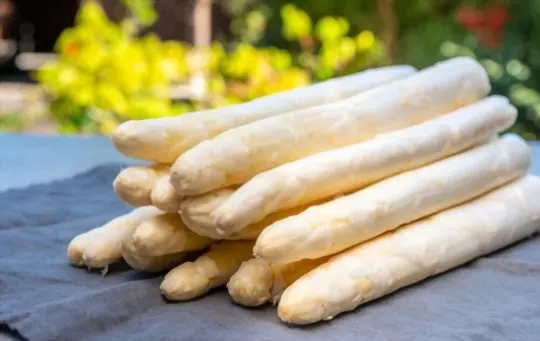You may have seen their cousins on display in the local markets and grocery stores.
When these delicious stalks are out, it’s usually a sign that the frost has melted, the snow is gone, and new life begins.
You are correct if you’ve been thinking of asparagus.
White asparagus, in particular, is quite a rare treat to find.
Especially when people are more familiar with their green counterparts, the regular green asparagus.
Nevertheless, they are equally delicious and amazing to add to your salads and vegetarian dishes.
If you haven’t tried this curious treat and want to know why the Europeans go crazy over them, stick around to know what does white asparagus taste like?
What is White Asparagus?

If you’re wondering if these ivory treats are just as tasty as their exotic green counterparts, you would be right.
The significant difference between white and green asparagus is in their cultivation process.
The plants are generally cultivated as vegetables suitable for harvest during spring.
They’re found in most parts of Europe and Asia, where the climate is temperate.
Identifying them is relatively easy; you should look for stocks or stem-like vegetables with a bulb at the top.
White asparagus look the same as their relatives but differ in colour. They sport an off-white to ivory hue.
And they are often referred to as ‘white gold’, ‘royal vegetable’ and ‘edible ivory’.
Being seasonal, they are available from late April to early June and can be found in many European dishes and west Asian cuisine.
The white asparagus undergoes a bleaching process during cultivation.
The tender shoots are hidden from light through blanching, giving it its unique colour.
What Does White Asparagus Taste Like?

Many have argued that white asparagus tastes softer and more delicate compared to green or purple asparagus.
When asked to pick one or the other, there’s always a great conflict for lovers of these vegetables.
But, in Germany, the edible ivory or ‘spragle’ rules all.
As they are almost the same plant, green and white asparagus, do share similar flavour notes.
However, the bitter tones can be more pronounced in the white asparagus.
They’ve often been compared to turnips and are said to have a more pronounced vegetal taste.
The nuttiness and grassy notes are followed by the sweetness that is typical of the asparagus family.
People frequently compare broccoli and artichokes, two extremely popular and delectable plants, to asparagus as another standard comparison.
The plant’s texture is crunchy, given its sturdy stalk and is odourless when used fresh.
Due to their unique structure, they are also compared to green beans and peas.
The plant also tastes similar to the heart of palms.
Since they are grown beneath mounds of earth, the photosynthesis process in the growing shoots is stunted.
Therefore, there are fewer grassy notes, and the bitterness is more pronounced.
This makes the plant easy to pickle and season, which is common in Germany.
The stalks can be cooked for extended periods because they are robust; this allows the vegetable to absorb the flavours of the foods it is served with.
Even under extremely high temperatures, the stalk retains its crunch.
How To Cook White Asparagus?

There are many ways to prepare this herbaceous vegetable, but all will agree that grilling it with butter is the most traditional way to plate it.
Adding a few dashes of lime and pepper will complete the simple meal, and you can pair it with other vegetables or meat.
White asparagus is a speciality in Europe, specifically in Germany and many parts of Asia.
There’s even a dedicated festival for the product called “Spargelzeit”.
The variety of asparagus shoots available here ranges from raw to pickled.
People will generally have it as a side accompaniment to the main dish since the bitterness can help offset rich flavours.
However, some like to use this dainty vegetable as the main attraction since it can pair well with strong spices and herbs.
An excellent way of serving them would be in soups where you can leave the stalks whole.
This is a more traditional method of cooking the dish and will win approval from anyone who tries it.
It’s also a great source of vitamins K, E, A and C and is high in antioxidants.
Conclusion
In addition to being lovely to look at, this plant is ideal for showing off your culinary skills to friends and family this spring.
You might find it difficult to prepare at first, but you won’t want anything else after you try it.
Due to its wide range of flavours and its versatility, while cooking, white asparagus is a rare delight that should be used on all occasions.
It should be a staple in everyone’s food list when in season.

What Does White Asparagus Taste Like? Does it Taste Good?
Ingredients
- White asparagus
- Ingredients from your favorite recipes
Instructions
- Depending on the ingredients used, the cooking method, and the type of dish, the taste of the food can vary greatly.
- Make sure to select a recipe that will elevate the food’s original flavor, and enjoy experimenting with different recipes!

Andrew Gray is a seasoned food writer and blogger with a wealth of experience in the restaurant and catering industries. With a passion for all things delicious, Andrew has honed his culinary expertise through his work as a personal chef and caterer.
His love for food led him to venture into food writing, where he has contributed to various online publications, sharing his knowledge and insights on the culinary world. As the proud owner of AmericasRestaurant.com, Andrew covers a wide range of topics, including recipes, restaurant reviews, product recommendations, and culinary tips.
Through his website, he aims to inspire and educate fellow food enthusiasts, offering a comprehensive resource for all things food-related.

Leave a comment